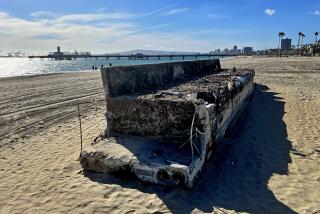Coral May Help Unearth Quake History
- Share via
NEWPORT BEACH — Builders have unearthed a rich cache of prehistoric animal remains on the site of a new car dealership, including twig-size pieces of ancient coral that may help chart the history of the region’s active earthquake fault.
The tiny remnants of branching coral found along Jamboree Road south of the Corona del Mar Freeway likely grew 300,000 to 600,000 years ago, when the site was under 100 feet of ocean water, scientists say. The rare find was shown at a Friday news conference, along with the remains of creatures that roamed the local foothills from 10,000 to 30,000 years ago.
“This is an extremely rich area for fossils, but the coral is unusual to see,” said Steven W. Conkling, a paleontologist hired to examine the find. “I’ve been working in this area for 11 years, and I’ve never seen branching coral like this before.”
The prehistoric sea life was dwarfed as it sat next to an ancient bison skull, the softball-sized “baby teeth” of a young mastodon and rust-colored remains of a whale. While Conkling conceded the ancient mammal remains were “more dramatic and flashy looking,” he said the coral held more scientific intrigue.
“It’s really out of this world,” he told reporters gathered at the Fletcher Jones Motorcars site. “Great stuff.”
*
The coral is nearly identical to a black, fan-like species that still sways in tropical waters, Conkling said. Both the modern and the ancient coral are among the few life forms that absorb natural uranium. In prehistoric coral, that translates to radioactive “markers” that give scientists a powerful tool to determine age.
Typically, carbon-dating techniques cannot accurately gauge the age of bones and fossils older than 40,000 years, Conkling said, but tests based on uranium can go back millions of years. So, with better information about the age and placement of the coral, researchers hope to map out ancient changes in the sea floor and fault lines that may help reveal seismic patterns.
“The past tells us what is possible for the future,” said Lisa Grant, a Chapman University geologist who studies Orange County earthquake history. “If it happened in the past, it can happen in the future. If you understand it, you can prepare for it.”
For decades, researchers have said the Newport-Inglewood fault could produce a massive earthquake. A 1994 Stanford University study projected that a magnitude 7 quake along the fault could cause as many as 5,000 deaths and $125 billion in damage. The fault generated a huge quake in Long Beach in 1933. Grant has found it also caused five other major quakes in the past 12,000 years.
Grant hopes to further map the fault’s history with the coral from the construction site, but she and Conkling say the find has already provided insights on the ocean.
*
The coral suggests the sea that covered the spot about half a million years ago was far warmer than the waters that now lap the shore about three miles to the southwest. Conkling says that evidence and other findings indicate the local waters were colder a million years ago, warmed and then cooled again. It could may be an ongoing cycle, he said.
“A million years ago, the water might have been similar to the cold environment that you would find now off of Washington state, then it warmed to something similar to Sonora, Mexico, before changing again,” Conkling said.
The finds at the site began 18 months ago when workers grading the property found a chunk of horse backbone that may be 10,000 to 30,000 years old. Experts were not surprised by the find. Digs in the area have long yielded a wealth of fossils and the remains of prehistoric humans and other animals.
Construction slowed as Conkling and other paleontologists were called in to exhume the bones of miniature antelope, bison, mastodon and whales, along with buckets of shells and 600,000-year-old sea dollars that hint of the warm water that preceded the land animals.
Next month, the site that has been the home of so much history will open as a 180,000-square-foot Mercedes-Benz dealership with a cappuccino bar and an on-site manicurist for customers awaiting oil changes. The luxury cars and modern amenities will share quarters with the newly found bones, which will be mounted as an educational display.
More to Read
Sign up for Essential California
The most important California stories and recommendations in your inbox every morning.
You may occasionally receive promotional content from the Los Angeles Times.













